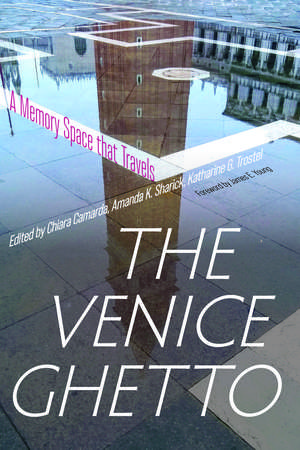The Venice Ghetto: A Memory Space that Travels
Editat de Chiara Camarda, Amanda K. Sharick, Katharine G. Trostel Cuvânt înainte de James E. Youngen Limba Engleză Paperback – 25 feb 2022
The Venice Ghetto was founded in 1516 by the Venetian government as a segregated area of the city in which Jews were compelled to live. The world's first ghetto and the origin of the English word, the term simultaneously works to mark specific places and their histories, and as a global symbol that evokes themes of identity, exile, marginalization, and segregation. To capture these multiple meanings, the editors of this volume conceptualize the ghetto as a "memory space that travels" through both time and space.
This interdisciplinary collection engages with questions about the history, conditions, and lived experience of the Venice Ghetto, including its legacy as a compulsory, segregated, and enclosed space. Contributors also consider the ghetto's influence on the figure of the Renaissance moneylender, the material culture of the ghetto archive, the urban form of North Africa's mellah and hara, and the ghetto's impact on the writings of Primo Levi and Marjorie Agosín.
In addition to the volume editors, The Venice Ghetto features a foreword from James E. Young and contributions from Shaul Bassi, Murray Baumgarten, Margaux Fitoussi, Dario Miccoli, Andrea Yaakov Lattes, Federica Ruspio, Michael Shapiro, Clive Sinclair, and Emanuela Trevisan Semi.
This interdisciplinary collection engages with questions about the history, conditions, and lived experience of the Venice Ghetto, including its legacy as a compulsory, segregated, and enclosed space. Contributors also consider the ghetto's influence on the figure of the Renaissance moneylender, the material culture of the ghetto archive, the urban form of North Africa's mellah and hara, and the ghetto's impact on the writings of Primo Levi and Marjorie Agosín.
In addition to the volume editors, The Venice Ghetto features a foreword from James E. Young and contributions from Shaul Bassi, Murray Baumgarten, Margaux Fitoussi, Dario Miccoli, Andrea Yaakov Lattes, Federica Ruspio, Michael Shapiro, Clive Sinclair, and Emanuela Trevisan Semi.
Preț: 238.01 lei
Nou
Puncte Express: 357
Preț estimativ în valută:
45.56€ • 49.50$ • 38.29£
45.56€ • 49.50$ • 38.29£
Carte disponibilă
Livrare economică 31 martie-14 aprilie
Livrare express 15-21 martie pentru 25.93 lei
Preluare comenzi: 021 569.72.76
Specificații
ISBN-13: 9781625346155
ISBN-10: 1625346158
Pagini: 296
Ilustrații: 19 b&w illus.
Dimensiuni: 152 x 229 x 23 mm
Greutate: 0.36 kg
Editura: University of Massachusetts Press
Colecția University of Massachusetts Press
ISBN-10: 1625346158
Pagini: 296
Ilustrații: 19 b&w illus.
Dimensiuni: 152 x 229 x 23 mm
Greutate: 0.36 kg
Editura: University of Massachusetts Press
Colecția University of Massachusetts Press
Notă biografică
CHIARA CAMARDA holds a PhD in Asian and African Studies from Ca' Foscari University of Venice. AMANDA K. SHARICK holds a PhD in English from the University of California, Riverside and is associate director for Harvard University's Graduate Commons Program. KATHARINE G. TROSTEL is assistant professor of English at Ursuline College.
Recenzii
"With cogent and compelling chapters organized to move the reader through a transhistorical and transnational context to highlight the ghetto's impact writ large, this volume will appeal to historians, literary critics, artists, and art historians of premodern and modern Europe and the Mediterranean, as well as Jewish studies scholars."—Dana E. Katz, author of The Jewish Ghetto and the Visual Imagination of Early Modern Venice
"A timely, conceptually rich collection based on new sources and translations that explore the ghetto as a palimpsest across time and space. An essential resource for students and scholars studying both the ghetto, in general, and the Venice Ghetto, in particular.”—Bryan Cheyette, author of The Ghetto: A Very Short Introduction
"A timely, conceptually rich collection based on new sources and translations that explore the ghetto as a palimpsest across time and space. An essential resource for students and scholars studying both the ghetto, in general, and the Venice Ghetto, in particular.”—Bryan Cheyette, author of The Ghetto: A Very Short Introduction
